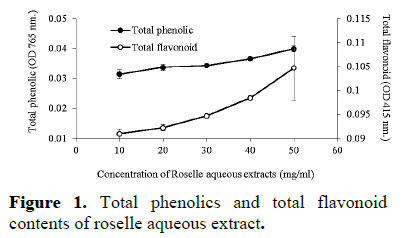Scavenging Capacity and Antibacterial Activity of Roselle Aqueous Extract and Wine Production
Keywords:
Roselle, Roselle wine, Scavenging capacity, Antibacterial activityAbstract
Roselle is an herbaceous medicinal plant where being native to Asia. The calyx of roselle action as well as its bioactive compounds and natural pigments. In this work, total phenolics, total flavonoids, scavenging capacity and antibacterial activity of roselle aqueous extract were investigated and applied as a substrate for wine production. Scavenging capacity of roselle aqueous extracts was increased dependently on dose of total phenolic compound in the extract. Roselle wine was produced and evaluated on pH, alcohol (%), total acids (%), total solids (oBrix), total viable counts of bacteria and yeast/mold for 10 days of fermentation. pH and total solids were significantly decreased from 0 day of fermentation, while alcohol, total acids and total viable counts of bacteria and yeast/mold were significantly increased until the end of process. Roselle aqueous extract at the concentration of 0.5 and 1 mg/ml inhibited the growth of Escherichia coli, Salmonella sp., Bacillus sp. and Staphylococcus aureus while wine products have no effect on antibacterial activity.
References
Alarcon-Alonso, J., Zamilpa, A., Aguilar, F. A., Herrera-Ruiz, M., Tortoriello, J., & Jimenez-Ferrer, E. (2012). Pharmacological characterization of the diuretic effect of Hibiscus sabdariffa Linn (Malvaceae) extract. Journal of Ethnopharmacology, 139(3), 751-756.
Andzi Barhé, T., & Feuya Tchouya, G. R. (2015). Comparative study of the anti-oxidant activity of the total polyphenols extracted from Hibiscus
sabdariffa L., Glycine max L. Merr., yellow tea and red wine through reaction with DPPH free radicals. Arabian Journal of Chemistry, 9, 1-8.
Association of Official Analytical Chemists (1990). Official methods of analysis (15th ed.). Washington, DC: Author.
Borrás-Linares, I., Fernández-Arroyo, S., Arráez-Roman, D., Palmeros-Suárez, P. A., Del Val-Díaz, R., Andrade-Gonzáles, I., … Segura-
Carretero, A. (2015). Characterization of phenolic compounds, anthocyanidin, antioxidant and antimicrobial activity of 25 varieties of Mexican Roselle (Hibiscus sabdariffa). Industrial Crops and Products, 69, 385-394.
Chang, C.-C., Yang, M.-H., Wen, H.-M., & Chern, J.-C. (2002). Estimation of total flavonoid content in propolis by two complementary colorimetric methods. Journal of Food and Drug Analysis, 10(3), 178-182.
Chao, C.-Y., & Yin, M.-C. (2009). Antibacterial effects of roselle calyx extracts and protocatechuic acid in ground beef and apple juice. Foodborne Pathogens and Disease, 6(2), 201-206. doi: 10.1089/fpd.2008.0187
Da-Costa-Rocha, I., Bonnlaender, B., Sievers, H., Pischel, I., & Heinrich, M. (2014). Hibiscus sabdariffa L.–A phytochemical and pharmacological review. Food Chemistry, 165, 424-443.
Diarra, M. S., Block, G., Rempel, H., Oomah B. D., Harrison, J., McCallum, J., … Malouin, F. (2013). In vitro and in vivo antibacterial activities
of cranberry press cake extracts alone or in combination with β-lactams against Staphylococcus aureus. BMC Complementary and Alternative Medicine, 13. doi: 10.1186/1472-6882-13-90
Ferguson, L. R. (2001). Role of plant polyphenols in genomic stability. Mutation Research, 475, 89-111.
Fernández-Arroyo, S., Herranz-López, M., Beltrán-Debón, R., Borrás-Linares, I., Barrajón-Catalán, E., Joven, J., … Micol, V. (2012). Bioavailability
study of a polyphenol-enriched extract from Hibiscus sabdariffa in rats and associated antioxidant status. Molecular Nutrition & Food Research, 56(10), 1590-1595.
Harrigan, W. F., & McCance, M. E. (1976). Laboratory methods in food and dairy microbiology. London: Academic Press.
Hopkins, A. L., Lamm, M. G., Funk, J. L., & Ritenbaugh, C. (2013). Hibiscus sabdariffa L. in the treatment of hypertension and hyperlipidemia:
a comprehensive review of animal and human studies. Fitoterapia, 85, 84-94.
Ifie, I., Marshall, L. J., Ho, P., & Williamson, G. (2016). Hibiscus sabdariffa (Roselle) extracts and wine: Phytochemical profile, physicochemical properties, and carbohydrase inhibition. Journal of Agricultural and Food Chemistry, 64(24), 4921-4931.
Ifie, I., Olurin, T. O., & Aina, J. O. (2012). Production and quality attributes of vegetable wine from Hibiscus sabdariffa Linn. African Journal of Food Science, 6(7), 212-215.
Jorgensen, J. H., Turnidge, J. D., & Washington, J. A. (1999). Antimicrobial susceptibility tests: Dilution and disk diffusion methods. Washington, DC: ASM Press.
Lister, E., & Wilson, P. (2001). Measurement of total phenolics and ABTS assay for antioxidant activity (personal communication). Lincoln,
New Zealand: Crop Research Institute.
Liu, K. S., Tsao, S. M., & Yin, M. C. (2005). In vitro antibacterial activity of roselle calyx and protocatechuic acid. Phytotherapy Research, 19(11), 942-945.
Mahadevan, N., Shivali, & Kamboj, P. (2009). Hibiscus sabdariffa Linn.– An overview. Natural Product Radiance, 8(1), 77-83.
Nishaa, S., Vishnupriya, M., Sasikumar, J. M., Hephzibah, P. C., & Gopalakrishnan, V. K. (2012). Antioxidant activity of ethanolic extract
of Maranta arundinacea L. tuberous rhizomes. Asian Journal of Pharmaceutical and Clinical Research, 5(4), 85-88.
Okoro, C. E. (2007). Production of red wine from roselle (Hibiscus sabdariffa) and pawpaw (Carica papaya) using palm-wine yeast (Saccharomyces cerevisiae). Nigerian Food Journal, 25(2), 158-164.
Omemu, A., Edema, M. O., Atayese, A. O., & Obadina, A. O. (2006). A survey of the microflora of Hibiscus sabdariffa (Roselle) and the resulting “Zobo” juice. African Journal of Biotechnology, 5(3), 254-259.
Opara, C. C., & Rexford, N. C. (2012). Production of wine from zobo (Hibiscus sabdariffa) flower juice. Journal of Biochemical Technology, 3(4),
-437.
Re, R., Pellegrini, N., Proteggente, A., Pannala, A., Yang, M., & Rice-Evans, C. (1999). Antioxidant activity applying an improved ABTS radical
cation decolorization assay. Free Radical Biology and Medicine, 26, 1231-1237.
Sacchi, K. L., Bisson, L. F., & Adams, D. O. (2005). A review of the effect of winemaking techniques on phenolic extraction in red wines. American Journal of Enology and Viticulture, 56(3), 197-206.
Sachdewa, A., Nigam, R., & Khemani, L. D. (2001). Hypoglycemic effect of Hibiscus rosa sinensis L. leaf extract in glucose and streptozotocin
induced hyperglycemic rats. Indian Journal of Experimental Biology, 39(3), 284-286.
United States Food and Drug Administration. (1993). FDA/CFSAN brochure on food colour facts. Retrieved from http://www.cfsan.fda.
gov/~Ird/colour fac.html













